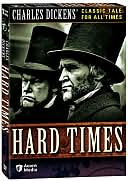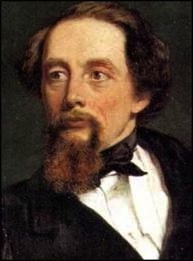“Be in all things regulated and governed by fact…”
Alway s concerned with issues of class, social injustice, and employment, Dickens shows in Hard Times, written in 1854, a broader concern with the philosophies and economic movements which underlie those issues. Three parallel story lines reflect a broad cross-section of society and its thinking. Mr. Thomas Gradgrind runs a school founded upon the principles of rationalism, a belief in the importance of facts, the antithesis of romantic “fancy” and imagination. Basically a good man, he denies the importance of emotion–for himself, his children, and his students. Only Student #20, Sissy Jupe, the daughter of a circus clown, fails to conform to his notions, and in a hilarious, satiric scene at the beginning of the novel, Dickens shows the absurdity of Gradgrind’s teachings.
s concerned with issues of class, social injustice, and employment, Dickens shows in Hard Times, written in 1854, a broader concern with the philosophies and economic movements which underlie those issues. Three parallel story lines reflect a broad cross-section of society and its thinking. Mr. Thomas Gradgrind runs a school founded upon the principles of rationalism, a belief in the importance of facts, the antithesis of romantic “fancy” and imagination. Basically a good man, he denies the importance of emotion–for himself, his children, and his students. Only Student #20, Sissy Jupe, the daughter of a circus clown, fails to conform to his notions, and in a hilarious, satiric scene at the beginning of the novel, Dickens shows the absurdity of Gradgrind’s teachings.
Gradgrind’s friend, Mr. Bounderby, is a banker and factory owner, aged fifty, who claims to have risen from the gutter to his present lofty position through hard work. Bounderby treats the employees of his Coketown factory as machines, rather than as humans, and his eventual marriage to the teenaged Louisa Gradgrind is seen by both as a marriage of “tangible fact,” having nothing to do with affection.
The third story line involves Stephen Blackpool, a worker in Bounderby’s factory, trapped in a marriage to an alcoholic who periodically appears and extorts money from him. Stephen is in love with Rachael, an adoring factory worker, but his appeal to Bounderby for help in ending his marriage is met with cold, rational pronouncements. Shortly after, Bounderby fires Stephen “for a novelty,” forcing him to seek employment elsewhere.
As the story lines overlap and intersect, often with consummate irony, Dickens keeps a light enough hand to prevent the story from becoming a polemic, though his criticism of hypocrisy, corruption, and “progress” at the expense of humanity is clear. His humor, often dark, keeps the plot moving, and several of his characters, which are often caricatures, do grow and change. Characteristically, Dickens uses names symbolically. Gradgrind grinds the emotions from his graduates; Mr. M’Choakumchild is a teacher, and lives at Stone Lodge; and Mr. Bounderby proves to be a bounder. Some of the circus performers, like Sissy, live at Pegasus Arms.
The dramatic conclusion, wh ich involves the pursuit of an innocent character widely believed to have committed a robbery, draws all the themes together, showing the parallels, contrasts, and ironies which connect these characters, regardless of their social level. Less epic in plot than some of Dickens’s other novels, Hard Times provides an intimate look at a changing economy and an important commentary on the philosophies of the times.
ich involves the pursuit of an innocent character widely believed to have committed a robbery, draws all the themes together, showing the parallels, contrasts, and ironies which connect these characters, regardless of their social level. Less epic in plot than some of Dickens’s other novels, Hard Times provides an intimate look at a changing economy and an important commentary on the philosophies of the times.
Also reviewed here are three other Dickens novels: NICHOLAS NICKLEBY, THE MYSTERY OF EDWIN DROOD, and BLEAK HOUSE. See Authors tab at the top of the Home page, if interested.
This novel is also available in a DVD version, shown here.
The painting of Charles Dickens may be found here and on other sites: http://www.novelhouse.com/Charles_dickens.htm It is located at the Victoria and Albert Museum

